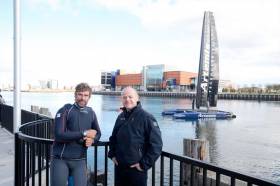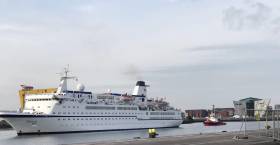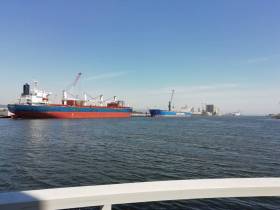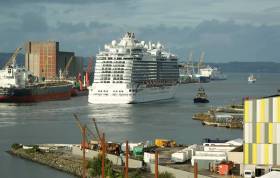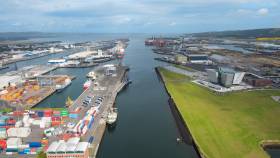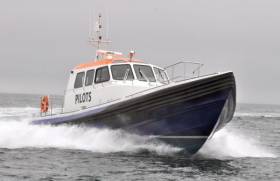Displaying items by tag: Belfast Harbour
Artemis Technologies’ Belfast-based bid for a carbon-free yacht-building project is in line for major seed funding, according to Sail World.
As previously reported on Afloat.ie, the company spun off from America’s Cup team Artemis Racing and led by double Olympic gold medalist Iain Percy announced plans last October to bring shipbuilding back to Belfast Harbour.
The company is developing an Autonomous Sailing Vessel or ASV, a 45-metre catamaran with a top speed of 50 knots, powered by renewables which will offer it unlimited range.
Percy said last year: ““We aim to lead in the decarbonisation of the maritime industry by building on our America’s Cup heritage and expertise in hydrofoils, wing sails and control systems to develop and manufacture green-powered commercial vessels, helping to ensure a sustainable maritime future.”
Artemis Technologies has now secured early-stage funding to pursue a full bid for UK Research and Innovation’s Strength in Places Fund.
Successful projects will receive anywhere from £10 million (€11.65 million) to £50 million (€58.3 million) to see their concepts through to fruition.
Percy described the new funding as “a major endorsement of our plans to make Belfast the advanced maritime manufacturing capital of the world.
“The city is already home to some of the most advanced aerospace and composite engineering talent available anywhere on the planet and we want to harness that potential by combining it with Belfast's rich maritime history and our own expertise in high-speed yacht design.”
Sail World has more on the story HERE.
Record Cruise Ships Due in Belfast Harbour This Year
#cruiseliners - A total 285,000 visitors on board 151 cruise ships are due to call at Belfast Harbour this year, an increase of 31% on the 115 visits during the 2018 cruise season.
The figures were announced by Cruise Belfast, the partnership between Belfast Harbour and Visit Belfast.
According to Cruise Belfast, July will be the busiest month with 32 ships scheduled to call among them SAGA’s first ever newbuild vessel Spirit of Discovery. Other first time callers to Belfast this year include Disney Magic and Cruise & Maritime Voyages which acquired a ship and renamed Vasco da Gama.
In total 35 separate cruise lines will call at Belfast, the most frequent being CMV with 15 calls scheduled and Princess Cruises set at 13 calls.
The Italian-based Costa Line will also call at Belfast for the first time while the number of calls from Celebrity will double to eight. Norwegian Cruise Line is expanding its visits from one in 2018 to eleven calls as part of its strategic growth plans for the northern European market.
#BelfastLough - Belfast Harbour announced its results for 2017 and has reported a record financial performance and a strong investment pipeline of £132m in port infrastructure.
In addition to port infrastructure, real estate projects are been targeted at improving the competitiveness of its operations and generating further growth.
Turnover in the year to December 31st 2017 was up 6.5% to £61.9million and operating profit up 5.6% to £34million. The growth in turnover and profits was supported by a 3% increase in port cargo handled to a record 23.7million tonnes, and additional income from the Harbour’s successful property developments in its City Quays river front offices and AC Marriott Hotel, plus new Film Studios on the North Foreshore.
During 2017 Belfast Harbour invested £42million in new port facilities and regeneration developments across its 2,000 acre Estate.
Future capital expenditure plans include an upgrade of the port’s ferry and container handling facilities at a cost of £60million, and further investments in new logistics warehousing units. Planned developments at City Quays include a new 900-space multi story car park currently under construction and a further 250,000 square foot Grade ‘A’ office building which is awaiting final planning approval.
The planned upgrade of ferry terminal facilities is in support of a major investment by Stena Line in new larger Roll-On/Roll-Off ferries which are due to start operation on Belfast routes in early 2020.(See related story: upgrade on Merseyside).
Belfast Harbour is also making a substantial investment in new cranes and terminal capacity improvements at the port’s container terminal at VT3. This terminal handles direct shipping services between Belfast and the key European hub ports of Rotterdam and Antwerp, and provides global connectivity for Northern Ireland’s exporters and importers.
Commenting on the annual report, Belfast Harbour’s Chairman, David Dobbin, said: “Belfast Harbour is a key economic driver for our region. Our Trust Port status allows us to reinvest all of our earnings after tax for the benefit of port users and the wider local economy. This ongoing investment cycle has been key to our financial success and has allowed us to support the growth in trade and passenger/visitor numbers, and the creation of quality new jobs across our estate.
“We estimate that our current investment programme will generate over 10,000 jobs. Over 2,000 jobs have already been delivered in the City Quays offices and hotel developments, and the Harbour Film Studios.”
Joe O’Neill, Belfast Harbour’s CEO, added: “A key factor in the success of Belfast Harbour is the ongoing growth in port throughput in sectors such as aggregates, steel, animal feeds and grains, Roll-On/Roll-Off freight, ferry passengers and cruise ship visits. Port operations account for c.80% of turnover and the continued delivery of best-in-class marine facilities remains our investment priority.
“The Harbour’s real estate activities also are delivering ongoing growth. As trade in traditional sectors such as coal and refined oil reduce, we will continue to explore new trade opportunities, alongside those in real estate and tradeable services. Our ongoing partnerships with Titanic Quarter and Catalyst Inc. also continue to yield positive results.”
During 2017, 5,874 ships arrived at Belfast Harbour. Over half a million freight vehicles passed through the port while passenger numbers rose by 9% to 1.5m.
The port welcomed 155,000 cruise passengers and Northern Ireland’s agri-food sector also continued to perform strongly with related trades handled increasing by 10% to almost 2.3m tonnes.
#BelfastHarbour - A total investment of £30M by Belfast Harbour and Northern Ireland-based LCC Group have put the city at the centre of the global supply chain for hi-tech coal.
Since opening last year, LCC’s £12M facility has handled almost 500,000 tonnes of processed coal which is exported directly across the world to destinations such as Saudi Arabia, Australia, Scandinavia, mainland Europe and North Africa. LCC’s investment and export opportunity is built upon a circa £20m investment by Belfast Harbour in recent years to enhance its deep water and cranage capability.
The LCC facility, the most sophisticated of its kind in the world, removes impurities from coal. The coal can then be used to produce ferro alloy and silica metals which are used in the manufacture of hi-end products such as solar panels and medical equipment. LCC imports coal to Belfast from Columbia for processing before onward export.
Over 130 direct and indirect jobs are supported by the operation including engineers, lab technicians and port support services.
Michael Loughran of LCC Group, said: “This £12m investment means that LCC operates one of the most environmentally friendly, state-of-the-art coal processing facilities to be found anywhere in the world. In addition to creating 30 new jobs and up to 100 indirect jobs in supporting sectors, the facility has put Belfast at the heart of the global hi-tech coal industry.
“Working in partnership with Belfast Harbour and building upon its investments in port infrastructure, LCC is now to the fore of the emerging clean-tech coal sector. The facility is designed to meet the most stringent 21st century environmental standards, and uses the most up-to-date technology to combat potential air and water pollution.”
Michael Robinson, Belfast Harbour’s Commercial Director, added: “In recent years Belfast Harbour has invested around £20m in a new deep-water quay and new larger cranes to enhance its bulk cargo operations in anticipation of our customers’ future needs. This has enabled the Port to handle ever larger vessels and accommodate LCC’s new facility beside its main bulk handling quay at Stormont Wharf.
“Belfast Harbour is now handling direct export shipments to Saudi Arabia for the first time in its history and recently exported bulk cargo to Australia for the first time in living memory. This new trade is also supporting jobs across a wide range of port services including stevedores and hauliers.”
As alluded above the port handled a shipment to Saudi Arabia last week which involved 20,000 tonnes of processed coal.
#CruiseLiners - According to Cruise Belfast 2018 will be another record cruise season for Belfast Harbour with 117 ships expected to dock in the city bringing more than 200,000 visitors to Northern Ireland.
25% more ships are booked to arrive in Belfast Harbour compared to last year including, eight new Cruise Lines which have added Belfast to their itineraries, joining the cruise industry’s leading operators Carnival, Royal Caribbean and Cunard. The City is also becoming increasingly popular with ‘Exploration and Adventure’ ships which operate at the luxury end of the market.
More than half of the ships calling will each bring over 1,000 visitors to Belfast with the largest ship, the 330m long Royal Princess, bringing more than 61,000 passengers to the City during her 12 calls. August will be the busiest month with 26 cruise calls bringing over 40,000 passengers and crew.
Among the new lines calling is Swiss-based Viking Line which has recently diversified into ocean going cruising having previously concentrated on the popular European river cruise market. Viking Line has scheduled four calls to Belfast in 2018 bringing almost 6,000 visitors in total. Other first time callers include ‘mega-yacht’ operator Variety Cruises, who are scheduled to call ten times this summer.
The length of Belfast’s cruise season has also extended with the first call due in mid-March and the last call in mid-October. For the first time it’s expected that passenger and crew numbers to Belfast will break the 200,000 mark, up almost 50,000 in a year.
By the end of the season Belfast Harbour will have welcomed over 700 ships and 1.2M cruise visitors since the first cruise ships visited the Port in 1996.
Details of the cruise schedule can be found on Belfast Harbour’s website www.belfast-harbour.co.uk/cruise-schedule/
Brexit: DUP Silent On '72 Per Cent' Trade Claim Out of Belfast Harbour
#DUPtradefigures - The Democratic Ulster Party (DUP) has been unable to substantiate its "72 per cent" statistic in relation to trade between Northern Ireland and Britain.
As The Irish News writes, for months the party has been using the figure to support its arguments against calls for an Irish Sea border post-Brexit.
DUP leader Arlene Foster has said "72 per cent of trade from Belfast Harbour is with Great Britain", while deputy leader Nigel Dodds has said Britain "is the primary marketplace for local produce, accounting for over 72 per cent of trade flows".
However, when asked to explain the exact meaning of the figure and provide its source, the party did not respond.
It has also emerged that official government statistics differ significantly from numbers used by Conservative MP Owen Paterson in his claims that trade between the UK and Republic is "really quite small".
The former secretary of state, an adviser to the Leave Means Leave campaign group, told BBC Radio 4's Today programme: "It's five per cent of Northern Ireland exports. It's 1.6 per cent of the Republic of Ireland's exports."
According to Northern Ireland Statistics and Research Agency (Nisra) figures, sales to the Republic actually account for 16 per cent of Northern Ireland's external sales.
Sales to Britain make up 58 per cent, according to the statistics for 2015 which include services and tourism. The rest of the EU is nine per cent, and 17 per cent for sales to the rest of the world.
It appears Mr Paterson's five per cent figure actually represents sales to the Republic as a proportion of Northern Ireland's overall internal and external sales activity.
Although it has been used in different ways, the DUP's figure appears to only relate to trade directly through Belfast Harbour, rather than the north's overall external sales or exports.
When asked about the claim, Belfast Harbour declined to give a formal response.
For more on the story, click the newspaper's report here.
Planning Permission Sought For New Belfast Cruise Terminal
#CruiseLiners - Belfast Harbour has submitted a planning application for a new cruise liner berth at Belfast Lough, as the Belfast Telegraph reports.
Belfast city councillors are this week expected to discuss the proposals for a £15 million (€16.5 million) terminal to handle growing cruise visitor numbers.
It’s the latest in a number of cruise berth plans around the island of Ireland, following similar proposals for Cobh on Cork Harbour and a revival of Dun Laoghaire’s large-scale liner ambitions.
The Belfast Telegraph has more on the story HERE.
#PilotBoats - Belfast Harbour has completed its £2 million deal with Redbay Boats for two new pilot boats to service the city’s busy waterfront, as The Irish News reports.
Already on service is the Captain Michael Evans named after the Belfast’s former deputy harbour master who was killed in the Manx2 Flight 7100 crash in Cork in 2011.
It’s now been joined by the Ben Madigan — also a Stormforce 1650, a new design by Redbay Boats based in Cushendall, Co Antrim, and celebrating 40 years in business this year.
The Irish News has more on the story HERE.
Cargo & Investments Boost Belfast Harbour To Record Profits
#BelfastHarbour - Belfast Harbour’s latest annual report shows a record €36.6 million in profits, according to The Irish Times.
The 12% rise in operating profits in 2016 comes with a 7% increase in turnover within the same 12-month period to more than €66 million.
This boost to Belfast’s bank balance has been driven by an increase in cargo throughput to more than 23 million tonnes, and revenue from its significant property portfolio around Belfast Lough.
Landholding interests of the harbour company — whose CEO Roy Adair will step down next year — include George Best Belfast City Airport and the new Belfast Harbour Studio at Giant’s Park, which will host the shoot for new US sci-fi TV series Krypton this summer.
The Irish Times has much more on the story HERE.
Belfast Harbour Confirm CEO to Retire Next Year
#PortCEO - Belfast Harbour have confirmed that CEO, Roy Adair CBE is to retire from the Port business in the Spring of 2018.
The CEO has for more than 12 years presided over an extremely successful development phase of Belfast Harbour delivering 12 consecutive years of growth. During this time the business has diversified through investment in both Port and Property activities.
Since 2005 Belfast Harbour has invested almost £250m in capital projects. This has included the single biggest capital investment the Port has ever made in the form of the £50m wind turbine D1 Renewable Energy Terminal.
During Adair's period in charge of the business he has overseen continued growth in Port trade activities and the expansion of the property side of the business which has seen the City Quays development emerge. The waterfront developement is delivering much needed Grade ‘A’ office space and hotel rooms for Belfast and the regional economy.
The Harbour has also invested in new and emerging industries exemplified by the recent completion of the £20m Belfast Harbour Studios making Northern Ireland the best catered for UK region in film production after London.
In addition to this the CEO has held a number of non-executive roles locally, nationally and internationally including Chairman of Business in the Community and serving as Prince Charles’ Ambassador for Social Responsibility.
The port has now started the process to appoint a successor for the role of CEO with adverts in local and national press.


























